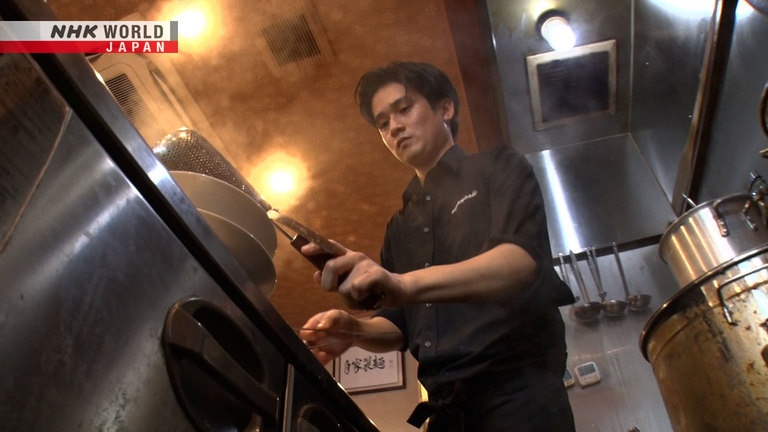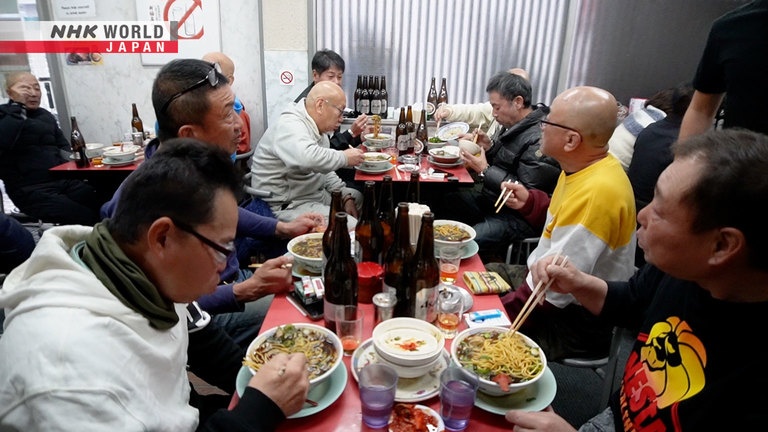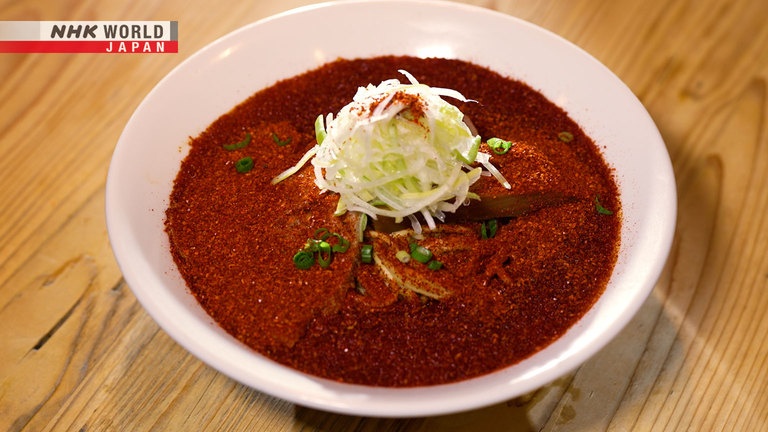Ramen Culture: The Continuous Evolution of Diverse Taste
Kyoto is not all traditional cuisine. It has become one of Japan's leading ramen hubs thanks to being a student town. Tastes evolve and flavors change as restaurants strive to satisfy clientele.




Transcript
Ramen - one of Japan's most well-known foods.
In a city dotted with ramen specialty shops, this dish has been a favorite among the locals for over 80 years.
Some 30 shops compete for business in the Ichijouji neighborhood which teems with university students.
Some even serve exceptionally rich ramen.
Kyoto cuisine is envisioned as
delicate and light,
but when it comes to ramen,
you'll find plenty of robust flavors.
We've made a breakthrough there.
Ramen cooks are nothing if not creative, with each striving to produce their own singular taste.
No single flavor defines Kyoto ramen,
and that's what makes it interesting.
The local culture affords each owner
leeway to create a signature taste.
Core Kyoto explores the passion of restaurant owners whose innovations enliven local ramen culture.
This old ramen restaurant is a five-minute walk from Kyoto Station.
It is considered the city's first such establishment.
Aoki Shigeyuki, the third owner, was originally a regular patron here.
The previous owner took a liking to him and handed him the reins.
He serves ramen under its original name, "chuuka soba," which translates into Chinese noodles.
Aoki's ramen features tender homemade braised pork belly, and a pitch-black,
concentrated broth made with dark soy sauce in chicken and pork bone stock.
The flavor is surprisingly light on the palate and ranks among Kyoto's typical ramen offerings.
We have regulars who
appear every morning.
We offer ramen that's not too heavy,
with a taste that can be enjoyed every day.
The restaurant has made a name for itself, and people even travel from afar to enjoy its "chuuka soba."
I'm from Tokyo.
The color is incredibly dark,
but the flavor is mild.
I'm from Kyoto and come all the time.
The ramen's delicious. I love it.
Regulars often enjoy fried rice along with their ramen.
The same soy sauce seasoning used in the "chuuka soba" creates the distinctive flavor.
The dish has remained a staple since the 1970s,
when the second owner first put it on the menu.
The fried rice pairs so well with the "chuuka soba" that they are also on offer as a combo meal.
This, the city's first ramen shop, opened in 1938,
initially as a food stall since ramen was still relatively unknown.
The business was launched by an immigrant from China.
A blend of Japanese stock and Chinese broth,
his ramen gained traction and the business moved to its current location in 1942.
Back then, the shop would open at 5 a.m. to serve patrons coming off the night shifts.
The recipe has been tweaked over the years, and now the eatery serves up to 2,000 bowls daily.
That tradition of opening early continues today.
Aoki begins his morning preparing the ramen soup.
You're late today.
This customer who has just completed the night shift helps himself to beer and proceeds to a table.
Strictly regulars.
Only those I know very well.
The shop officially opens at 9 a.m., but Aoki serves long-standing regulars
during the early morning hours as a special service.
He offers up a plateful of ramen toppings for each customer to nibble on while they enjoy a post-work beer.
The regulars keep arriving.
Aoki waits on them as he continues preparing for the day's business.
The soup is a blend of chicken and
pork stocks, but mainly chicken,
and we don't use any vegetables.
The ramen's key flavoring comes from the sauce used to braise the pork.
This tints the ramen soup a dark black.
Just after six, and the shop is almost full.
The regulars all know each other well and have their own preferred seats.
Someone stumbling on the scene would find it hard to believe this is early morning.
I like the taste and the owner.
At first, he turned me away, insisting it was
too soon to be considered a firm regular.
Some patrons drive over five hours to dine here.
I'm from Nagano Prefecture.
The food is delicious,
and the atmosphere is great.
One hour prior to opening.
Aoki makes himself a bowl of "chuuka soba" using the soup he prepared fresh that morning.
This is breakfast, but it is also an opportunity to taste that day's broth.
Aoki believes that as long as he himself never tires of the flavor day after day, the regulars will keep coming back.
At this hour, only regular patrons are dining downstairs.
They're all loyal fans.
They kept me going during
the three years of covid.
It was these regulars who kept the business afloat, which had dried up during the pandemic.
Aoki continues to serve "chuuka soba" today out of gratitude to all of them.
It's incredibly good.
Look, no soup left. It was perfect.
Ten to nine.
Normal morning business hours are about to begin,
and the regulars settle their bills.
Now, the general public filters in.
I'm not sure whether
I have 5 or 10 years left,
but I'd like to keep making ramen
till the day I die.
It's my hobby now,
and I will always give it my best.
Kita-shirakawa is another area brimming with students and home to one of Kyoto's oldest ramen shops.
In 1949, Masutani Hidetoshi and his wife Teruyo set up a roadside food stall near Kyoto University,
drawing domestic and exchange students alike.
Their daughter Kazuko helped out and describes how the ramen acquired its unique flavor.
There was a dorm for Chinese and
Taiwanese students down the hill.
When they came to eat ramen, they
offered my parents suggestions.
Kyoto University professors also gave advice
on how to prepare Chinese soup stock.
Then, business increased
by word of mouth.
Today, the shop remains an integral part of the Kyoto ramen scene.
The Masutanis wanted to give students extra nutrition in a single bowl of ramen
so they used pork back fat as their ramen's key component.
The soup is made by slowly simmering chicken bones with soy sauce seasoning.
This gives a slightly heady flavoring that pairs well with a bowl of steamed rice.
Osaka inherited her parents' secret recipe,
which is said to be the origins of a Kyoto-style of ramen that uses back fat.
Today, many shops around Japan have also adopted similar recipes.
It looks rich, but it's not that heavy.
I've been coming here for
as long as I can remember.
I've tried other places,
but this is unique.
This is my third visit
this week.
This now-classic taste still reigns in Kyoto.
This noodle factory was founded almost a century ago.
It has supplied Kyoto ramen restaurants for decades and now fills orders from across the country.
This latest expansion is the work of proprietor Chiken Yoshinori.
He continually looks for innovations.
The founder attended college in Tokyo
during an unprecedented "chuka soba" boom.
He saw a potential
business chance.
He knew that Kyotoites welcome novelty
and have a keen interest in anything new.
Although ramen was supposedly introduced to Tokyo as "chuuka soba" in 1910,
it did not immediately find its way to Kyoto.
Not until Chiken's grandfather, Kizou, came along.
Kizou opened Kyoto's first Chinese noodle factory in 1931
and sold his noodles to diners which were opening and succession at the time.
These eateries catered to the masses with popular dishes like udon noodles and rice bowls.
Since ramen was unknown at the time,
Kizou travelled around with samples, demonstrating how to prepare the noodles.
A diner chain and other restaurants picked up the novelty, and it became a staple menu item.
That all occurred before the dawn of Kyoto's ramen establishments.
Our shop was a branch of the diner
where my father trained.
Gradually, other branches were opened, and
ramen became a favored dish in the eateries.
While business initially thrived, it declined under the second proprietor due to increased competition.
Then, under Yoshinori, business bounced back.
He offered special-order noodles to individual ramen shops, an unusual move for a noodle factory.
It all started with a customer's request for "tsukemen," or dipping noodles, in 2005,
a time when Kyotoites had not yet caught on to the style of dipping ramen noodles into sauce.
Yoshinori and his client spent one year developing chewy noodles which could hold their own in a rich soup.
He's willing to try anything.
He never gives up.
You can count on him
to hang in there.
This fueled a "tsukemen" boom in Kyoto.
Social media took off about that time
and gave ramen a life of its own.
That success turned business around, and today the factory produces some 200 varieties of noodles.
Thin, straight noodles are ideal with a light soy sauce-flavored soup.
Crinkled egg noodles, meanwhile, are a perfect match for miso ramen.
And flat noodles suit a richer soup.
Noodles with a semicircular cross-section are more easily coated by the soup.
There are a few tricks in creating such a rich variety of noodles.
One is the slicing process in which sheets of dough are cut into thin strips.
Cylindrical cutters are adjusted to give the desired thinness and shape to the noodle.
More than 60 cutters are used to fill the varied custom orders.
We developed this cutter with wing blades
to produce noodles with raised sides.
The winged parts become soft when boiled and the center chewy for interesting noodles.
These noodles were first envisioned for a soup-less style of ramen
topped with minced meat and other ingredients.
The noodles' raised edges were designed to catch the bits of meat.
From here, you can see
our most advanced line.
The kneader creates thin bundles
to be pressed from the sides and the top.
The goal is to create noodles
with a handmade look.
This abundance of noodle varieties has aided the evolution of Kyoto ramen.
This shop uses both the straight noodles and the type that look hand-kneaded
to complement two different soups referred to as "white" and "black."
The base is a clear soup derived from three types of chicken stock,
simmered at a low heat, then well-skimmed to ensure a clear broth.
The "white" soup is blended with lighter, slightly sweet soy sauce.
We use flat, hand-kneaded noodles
for the white soup.
They have
a low water content.
Our light chicken broth coats the noodles,
helping to highlight the taste of the wheat.
The black soup also begins with the base broth but incorporates fish stock and aged soy sauce.
Toyomoto uses thin, straight noodles with a firmer bite for this soup.
Kyoto has an enormous number of restaurants,
boosted by an innovation-friendly environment.
So our next step is to create an opportunity
to introduce our products overseas.
The Ichijouji area is known for its concentration of university students and ramen restaurants.
One such restaurant, which opened in 2011, has made an impact on Kyoto's ramen scene.
The shop serves up ramen not found elsewhere.
It's hearty but not too heavy,
which makes it delightful.
The soup is quite creamy.
I used the sliced pork
to wipe the bowl clean.
Everyone agrees the soup is "rich."
Whole chickens are simmered until the stock thickens and becomes more like a creamy soup than a broth.
The soup is so thick that the noodles stay afloat.
The robust chicken flavor spreads across the palate.
This one-of-a-kind taste transformed ramen stereotypes.
The owner opened his own shop
after completing training,
but he struggled to create
his own signature flavor.
After 12 years of trial and error,
he finally hit upon this hearty chicken soup.
We thought the thick, rich flavor
would mostly appeal to men,
but we are now also drawing female
patrons since they tend to like chicken.
The shop also serves another popular ramen.
Here you are. Red ramen.
Their standard, hearty ramen is liberally sprinkled with chili peppers.
Customers say the robust chicken and red chili pepper combination is addictive.
The repeat customers, both men and women alike, usually consume the whole dish, soup and all.
Kyoto cuisine is envisioned as
delicate and light,
but when it comes to ramen,
you'll find plenty of robust flavors.
We've made a breakthrough there.
In 2022, one shop became an overnight sensation in the ramen community.
It was featured in an international gourmet guidebook just eight months after opening.
The standout ingredient, evocative of Kyoto, is the use of "sansho"
which is featured in Japanese cuisine.
At the time, almost no one in Kansai
used "sansho."
I thought it was a very Kyoto-like ingredient,
so I experimented to create a unique ramen.
Hot oil is drizzled over the "sansho" to extract a refreshing aroma.
"Sansho"'s aroma dissipates quickly,
so we make it fresh every morning.
The soup, which is produced from pork bones, seafood, and carefully selected chicken stock,
is left overnight to allow the flavors to emerge.
Scallops are marinated in white soy sauce then pulled and added to the soup.
This innovative "sansho" ramen has wowed connoisseurs.
"Hai, dozo."
"Irasshaimase."
The refreshing aroma of "sansho" blends with the delicious flavor of scallops, teasing the palate.
Made in-house, the flat, thin noodles are easily coated by the soup, resulting in a silky, chewy texture.
This ramen excites on many fronts; its emergence reflects the culinary influence of Kyoto,
which is home to many ramen shops.
Itou has been a ramen fan since childhood.
He founded the Ramen Study Group at university and would consume some 500 servings of Kyoto noodles annually.
Itou concocted his own ramen recipe and sold the noodles at student festivals.
The owner of a local ramen restaurant helped him out at no cost.
After graduation, he worked for a major flour manufacturer, where he learned the basics.
Eventually, he developed his idiosyncratic style of ramen and opened his own shop.
The "noren" gifted by the members of his study group still hangs across the shop entrance.
On this day, current members of the Ramen Study Group have gathered at Itou's shop.
They carry on the tradition of selling ramen at the school festival
and have borrowed his kitchen for preparation.
Chicken has always ruled the coop,
so this year we thought we'd try pork.
Preparation is hard work, but we have
fun since it is for the school festival.
The study group has just celebrated its tenth anniversary.
The ramen industry's senior members
helped me out back when,
and now it's my turn
to give something back.
The group's pork-based, soy ramen was a hit, generating a long line.
The group sold over 1,000 bowls during the three-day festival.
I'm motivated to create ramen culture.
I want to make my ramen as distinctive
as customers will allow -
and be viewed as a leader
in Kyoto's ramen culture.
Kyoto ramen is a diverse and creative cuisine in its own right.
This unique culture has become a new Kyoto "tradition, in evolution"
- bolstered by the Kyotoite spirit of progress and innovation.